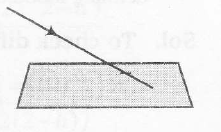Answer:
Option A
Explanation:
Concept Involved
It is based on two concepts one is the intersection of straight line
and plane and other is the foot of the perpendicular from a point to the straight
line.
Description of situation
(i) if the straight line
$\frac{x-x_{1}}{a}-\frac{y-y_{1}}{b}$
=$\frac{z-z_{1}}{c}=\lambda$

intersect the plane Ax+By+Cz+d=0
Then , $(a \lambda+x_{1},b \lambda+y_{1},c \lambda+z_{1})$ would satisfy
Ax+By+Cz+d=0

(ii) If A is the foot of perpendicular from P to l.
Then, (dr's of PA) is perpendicular to dr's of l.
$\Rightarrow$ $\overline{PA}.l=0$
Sol. Equation of straight line QR, is
$\frac{x-2}{1-2}=\frac{y-3}{-1-3}=\frac{z-5}{4-5}$
or $\frac{x-2}{-1}=\frac{y-3}{-4}=\frac{z-5}{-1}$
or $\frac{x-2}{1}=\frac{y-3}{4}=\frac{z-5}{1}=\lambda$
or $\frac{x-2}{1}=\frac{y-3}{4}=\frac{z-5}{1}=\lambda$ ..........(i)
$\therefore$ $P(\lambda+2,4\lambda+3,\lambda+5)$ must lie on 5x-4y-z=1
$\Rightarrow$ $5(\lambda+2)-4(4\lambda+3)-(\lambda+5)=1$
$\Rightarrow$ $5 \lambda+10-16 \lambda-12-\lambda-5=1$
$\Rightarrow$ $-7-12\lambda=1$
$\lambda=\frac{-2}{3}$ or $P\left(\frac{4}{3},\frac{1}{3},\frac{13}{3}\right)$.......(ii)
Again we assume S from (i) as $S(\mu +2,4\mu + 3, \mu + 5)$
dr's of TS = $(\mu+2-2, 4\mu + 3-1, \mu + 5-4 )$
$(\mu, 4\mu+2, \mu + 1)$
and dr's of QR =(1,4,1)
since, perpendicular
$\because$ $1(\mu)+4(4 \mu+2)+1(\mu+1)=0$
$\Rightarrow$ $\mu=-\frac{1}{2}$ and $S(\frac{3}{2},1,\frac{9}{2})$...(iii)
$\therefore$ Length of
PS= $\sqrt{\left(\frac{3}{2}-\frac{4}{3}\right)^{2}+\left(1-\frac{1}{3}\right)^{2}+\left(\frac{9}{2}-\frac{13}{3}\right)^{2}}$
$=\frac{1}{\sqrt{2}}$